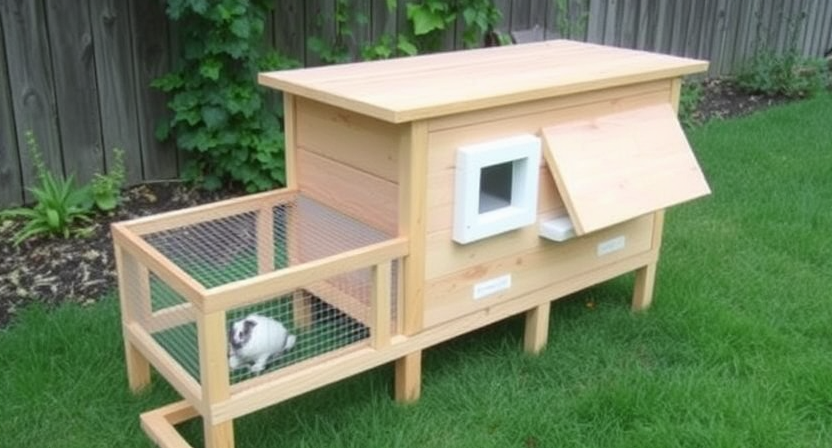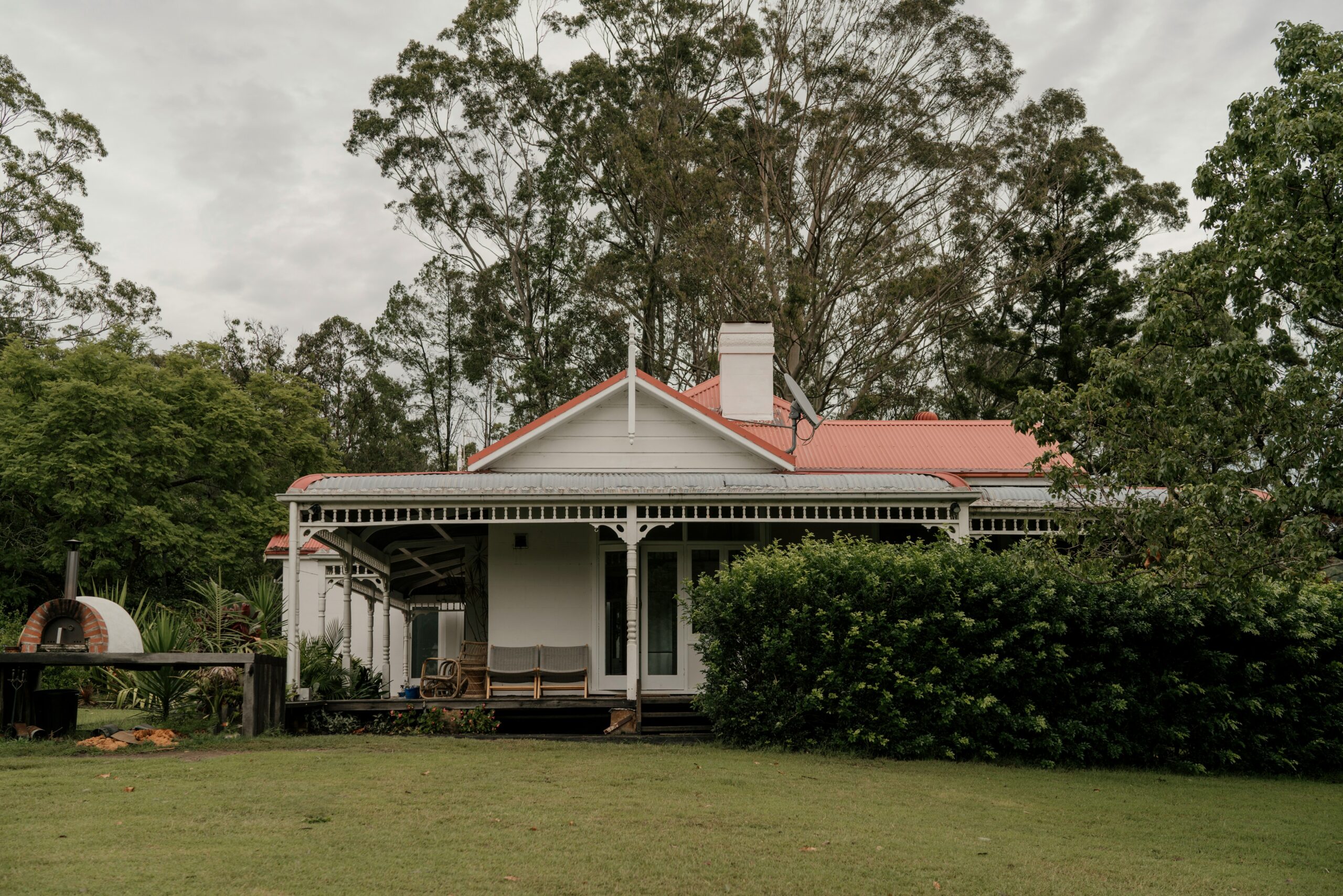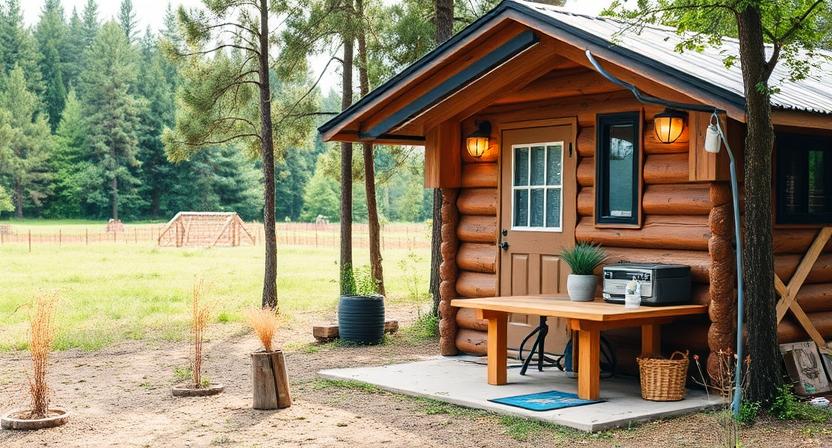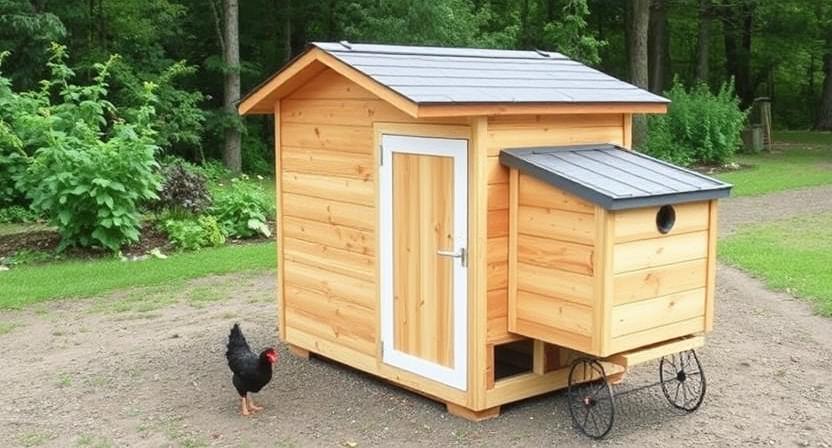How to Build a Rabbit Hutch with Simple Materials

Materials needed for building a rabbit hutch

To build a rabbit hutch, gather the following materials: 2×4 lumber for the frame, plywood for the floors and walls, wire mesh for ventilation, hinges and latches for the doors, roofing material for the roof, insulation for temperature control, a nesting box for comfort, a water bottle holder, a feeder, a litter box for easy cleaning, wheels for mobility, paint or stain for protection, and finishing touches such as handles and locks. These materials are essential for constructing a sturdy and comfortable home for your rabbits.
Additionally, you will need tools such as a saw for cutting the wood, a drill for assembling the frame, screws and nails for securing the structure, wire cutters for working with the wire mesh, and a hammer for various tasks. Having these tools on hand will help streamline the building process and ensure that your rabbit hutch is constructed efficiently and effectively.
• 2×4 lumber for the frame
• Plywood for the floors and walls
• Wire mesh for ventilation
• Hinges and latches for the doors
• Roofing material for the roof
• Insulation for temperature control
• Nesting box for comfort
• Water bottle holder
• Feeder
• Litter box for easy cleaning
• Wheels for mobility
• Paint or stain for protection
• Finishing touches such as handles and locks
In addition to these materials, you will also need tools such as a saw, drill, screws, nails, wire cutters, and a hammer. These tools are essential in constructing a sturdy rabbit hutch efficiently. Having all necessary materials and tools ready before starting your project will help ensure smooth progress throughout the building process.
Choosing the right location for your rabbit hutch

When selecting the ideal location for your rabbit hutch, it is vital to consider factors that will ensure the comfort and safety of your furry friends. Choose a spot that offers protection from extreme weather conditions such as direct sunlight, rain, or strong winds. A sheltered area can help prevent your rabbits from getting too hot or too cold, ensuring their well-being.
Furthermore, opt for a location that provides adequate ventilation to maintain good air quality inside the hutch. Proper airflow can help prevent the build-up of moisture and odors, creating a healthier environment for your rabbits. Additionally, placing the hutch in an area with good natural lighting can positively impact the rabbits’ well-being and overall mood. By carefully selecting the right location for the hutch, you can create a comfortable and safe living space for your beloved pets.
• Choose a spot that offers protection from extreme weather conditions
• Ensure sheltered area to prevent rabbits from getting too hot or too cold
• Opt for a location with adequate ventilation for good air quality inside the hutch
• Proper airflow can prevent build-up of moisture and odors
• Place hutch in an area with good natural lighting for positive impact on rabbits’ well-being
Designing a simple and effective layout for the hutch

When designing the layout for your rabbit hutch, consider the needs of your rabbits and how you can best provide a comfortable and safe environment for them. Start by incorporating separate areas for sleeping, eating, and playing within the hutch to promote a sense of security and stimulation for your furry companions. It’s important to ensure there is enough space for your rabbits to move around freely and stretch their legs, so plan the layout accordingly to accommodate their size and activity levels.
Additionally, strategically place the nesting box, feeder, water bottle holder, and litter box within the hutch to create a functional and organized living space for your rabbits. By grouping these essential elements together, you can streamline the daily care routine and make it easier for both you and your rabbits to access these necessities. Take into consideration the positioning of these components to optimize the flow and usability of the hutch, ultimately enhancing the overall well-being of your rabbits in their new home.
• Provide separate areas for sleeping, eating, and playing within the hutch
• Ensure there is enough space for rabbits to move around freely and stretch their legs
• Incorporate nesting box, feeder, water bottle holder, and litter box in strategic locations
• Group essential elements together to streamline daily care routine
• Position components to optimize flow and usability of the hutch
Measuring and cutting the wood for the frame

When measuring and cutting the wood for the frame of your rabbit hutch, accuracy is key. Begin by measuring the dimensions required for the frame according to your hutch design plans. Ensure that all cuts are precise and straight to guarantee a sturdy structure for your rabbits’ home. It is advisable to use a measuring tape, pencil, and a carpenter’s square to mark and cut the wood accurately.
Once you have carefully measured the necessary lengths, proceed to cut the wood using a saw that is appropriate for the type and thickness of the wood. Take your time to make clean and accurate cuts to avoid splintering or uneven edges. Remember to double-check your measurements before cutting to prevent any errors that could affect the overall stability and functionality of the frame.
• Use a measuring tape, pencil, and carpenter’s square for accurate measurements
• Ensure all cuts are precise and straight
• Choose the appropriate saw for the type and thickness of wood
• Take your time to make clean and accurate cuts
• Double-check measurements before cutting
Assembling the frame of the rabbit hutch

Next, align the pre-cut pieces of wood according to the blueprint layout. Ensure that the corners are square and the measurements are accurate before securing the pieces together. Use a screwdriver or a nail gun, depending on the chosen fastening method, to attach the pieces firmly.
Once the frame is assembled, double-check all connections to guarantee stability and strength. Test the frame by gently shaking it to ensure it can withstand the weight of the hutch and its inhabitants. Make any necessary adjustments before proceeding to the next step of adding the floor to the structure.
• Align the pre-cut pieces of wood according to the blueprint layout
• Ensure corners are square and measurements are accurate before securing pieces together
• Use a screwdriver or nail gun to attach pieces firmly
• Double-check all connections for stability and strength
• Test frame by gently shaking it to ensure it can withstand weight of hutch
• Make necessary adjustments before adding floor to structure
Adding a sturdy floor to the hutch

To ensure the structural integrity of the rabbit hutch, it is crucial to add a sturdy floor that can support the weight of the rabbits and provide insulation from the ground. Plywood is a commonly used material for constructing the floor of the hutch due to its durability and affordability. Cut the plywood to fit the dimensions of the hutch frame, ensuring a snug and secure fit.
After cutting the plywood to size, place it on top of the frame and secure it in place using screws or nails. Make sure the floor is level and stable to prevent any uneven surfaces that could cause discomfort to the rabbits. Adding a sturdy floor not only provides a comfortable surface for the rabbits to rest on but also helps protect them from moisture and drafts that may come from the ground.
• Measure the dimensions of the hutch frame accurately before cutting the plywood
• Use a saw to cut the plywood to fit snugly inside the hutch frame
• Secure the plywood floor in place using screws or nails to prevent shifting
• Check for any gaps or uneven surfaces that could cause discomfort to the rabbits
• Consider adding a layer of insulation underneath the plywood for added warmth and comfort
Installing wire mesh for ventilation and protection

To ensure proper ventilation and protection for your rabbits, installing wire mesh on the rabbit hutch is essential. This step allows for adequate airflow to keep the rabbits comfortable and prevent the buildup of stale air. The wire mesh also serves as a protective barrier, keeping predators out and ensuring the safety of your rabbits.
When installing the wire mesh, make sure to securely fasten it to the hutch frame using staples or nails. Ensure that there are no gaps or loose edges where predators could potentially enter. Additionally, consider the size of the mesh holes to prevent any small animals or insects from getting through. By properly installing the wire mesh, you are creating a safe and comfortable environment for your rabbits to thrive in.
• Securely fasten wire mesh to hutch frame using staples or nails
• Check for gaps or loose edges that predators could enter through
• Consider size of mesh holes to prevent small animals or insects from getting through
• Create a safe and comfortable environment for rabbits to thrive in
Creating a door for easy access to the hutch

To provide easy access to your rabbit hutch, you will need to create a sturdy and secure door. The door should be large enough for you to comfortably enter the hutch for cleaning and caring for your rabbits. Measure the opening designated for the door and cut the wood to fit accordingly. Consider adding a latch or lock to ensure the door stays closed and predators are unable to gain access to your rabbits.
Once the door is constructed, attach it to the hutch frame using durable hinges that can support the weight of the door. Test the door to ensure it opens and closes smoothly without any obstructions. Additionally, consider adding a small window or ventilation holes to the door to promote air circulation within the hutch. By creating a well-designed door, you can make caring for your rabbits a much more manageable task.
• Measure the opening for the door and cut the wood to fit
• Add a latch or lock for security
• Use durable hinges to attach the door to the hutch frame
• Test the door for smooth opening and closing
• Consider adding a window or ventilation holes for air circulation
Building a roof to protect the rabbits from the elements

When constructing a roof for your rabbit hutch, make sure to use durable and weather-resistant materials to provide adequate protection for your rabbits. Choose a sloped design to ensure proper water drainage and prevent any buildup that could compromise the hutch’s integrity. Additionally, consider adding an overhang to provide extra shade and shelter from rain or snow.
Proper insulation is key when building a roof for your rabbit hutch to help regulate the temperature inside. Utilize materials such as polystyrene or foam insulation to ensure your rabbits are comfortable in both hot summers and chilly winters. Pay attention to details such as sealing any gaps or seams to prevent drafts and keep your rabbits cozy and safe inside their hutch.
• Use durable and weather-resistant materials
• Choose a sloped design for proper water drainage
• Add an overhang for extra shade and shelter
• Utilize insulation like polystyrene or foam
• Seal any gaps or seams to prevent drafts
Adding insulation for temperature control

Insulation is an essential component of a well-designed rabbit hutch, helping to regulate the temperature inside the enclosure. By adding insulation, you can ensure that your rabbits are comfortable and protected from extreme weather conditions throughout the year. This is especially important during the colder months, as insulation helps to retain the heat generated by the rabbits’ bodies, keeping them warm and cozy.
When selecting insulation materials for your rabbit hutch, consider options like straw, hay, or specialized insulation panels. These materials not only provide thermal protection but also offer additional bedding for your rabbits to nestle into. Proper installation of the insulation is crucial to maximize its effectiveness, ensuring that there are no gaps or exposed areas that could compromise its insulating properties.
• Insulation is crucial for regulating temperature in a rabbit hutch
• Helps protect rabbits from extreme weather conditions
• Retains heat generated by rabbits’ bodies, keeping them warm
• Options for insulation materials include straw, hay, and specialized panels
• Provides additional bedding for rabbits to nestle into
• Proper installation is key to maximizing effectiveness of insulation
Installing a nesting box for the rabbits

To provide your rabbits with a cozy space to rest and feel secure, installing a nesting box is essential. A nesting box serves as a safe haven for mother rabbits to give birth and nurse their young ones. When installing the nesting box, make sure it is placed in a quiet and secluded area of the hutch to provide the rabbits with privacy and comfort.
Choose a sturdy and appropriately sized nesting box that can accommodate the mother rabbit and her litter comfortably. Make sure the nesting box is lined with soft bedding material such as straw or hay to keep the newborn rabbits warm and cozy. Ensure the nesting box is easily accessible for the mother rabbit but also secure enough to protect the babies from any potential harm. When the nesting box is properly installed, it creates a nurturing environment for the rabbits to thrive and bond as a family unit.
• Choose a sturdy and appropriately sized nesting box
• Line the nesting box with soft bedding material such as straw or hay
• Ensure the nesting box is easily accessible for the mother rabbit
• Place the nesting box in a quiet and secluded area of the hutch
Creating a ramp for easy access to the hutch

To provide easy access for your rabbits to enter and exit the hutch, constructing a ramp is essential. The ramp should have a gentle slope to ensure that the rabbits can navigate it comfortably. You can use sturdy wood to create the ramp, making sure it is wide enough for the rabbits to move up and down without any difficulty.
Position the ramp securely against the hutch, ensuring that it is stable and does not wobble when the rabbits use it. Adding a non-slip surface such as rubber or textured paint can help prevent any accidents or injuries. By incorporating a well-built ramp into the design of your rabbit hutch, you are not only enhancing the functionality of the structure but also prioritizing the comfort and safety of your furry companions.
• Position the ramp securely against the hutch
• Ensure it is stable and does not wobble
• Use sturdy wood for construction
• Make sure the ramp has a gentle slope
• Add a non-slip surface such as rubber or textured paint
Adding a water bottle holder for hydration

Lastly, it is essential to include a water bottle holder within the rabbit hutch to ensure that your furry friends have constant access to fresh water. This holder should be securely attached to the hutch at a height that is easily accessible for the rabbits. By providing a reliable source of hydration, you are promoting the health and well-being of your rabbits, preventing dehydration and related health issues.
When selecting a water bottle holder, opt for a sturdy and durable design that can withstand the playful nature of rabbits. It is also important to regularly check and refill the water bottle to ensure that your rabbits always have an adequate water supply. By incorporating a water bottle holder into your rabbit hutch, you are addressing a fundamental need of your rabbits and promoting their overall health and happiness.
• Ensure that the water bottle holder is securely attached to the hutch
• Place the water bottle holder at a height easily accessible for the rabbits
• Select a sturdy and durable design that can withstand rabbit’s playful nature
• Regularly check and refill the water bottle to ensure an adequate water supply
• Promote overall health and happiness of your rabbits by providing constant access to fresh water.
Installing a feeder for easy access to food

When it comes to ensuring your rabbits have easy access to food, installing a feeder in the hutch is essential. This allows for a convenient way to provide them with hay, pellets, and fresh vegetables without the risk of contamination or spillage. The feeder should be securely attached to the hutch to prevent any accidental tipping over or spillage that may attract pests or cause a mess inside the enclosure.
Depending on the size of your rabbits and the type of food you are providing, you can choose a feeder that best suits their needs. Gravity-fed feeders can be ideal for hay and pellets, while dish feeders can work well for fresh vegetables. Make sure to regularly check and refill the feeder to ensure your rabbits always have access to fresh and nutritious food.
• Gravity-fed feeders are ideal for hay and pellets
• Dish feeders work well for fresh vegetables
• Securely attach the feeder to prevent tipping over or spillage
• Regularly check and refill the feeder to ensure access to fresh food
Building a litter box for easy cleaning

To create a litter box for your rabbit hutch, you will need a shallow container that is large enough for your rabbit to comfortably move around in. Choose a box that is made of durable material and easy to clean, such as plastic or metal. Make sure the edges of the box are low enough for your rabbit to easily hop in and out. Line the bottom of the box with a layer of rabbit-safe bedding or litter to absorb moisture and control odors. Avoid using clumping cat litter or cedar shavings, as these can be harmful to rabbits if ingested.
Once the litter box is set up, place it in a corner of the hutch where your rabbit tends to prefer going to the bathroom. Rabbits are naturally inclined to use the same spot for their bathroom activities, so observe their behavior to determine the best location for the litter box. Monitor the box regularly and clean it out as needed to maintain a clean and hygienic environment for your rabbits. By providing a designated area for your rabbits to relieve themselves, you can easily keep the rest of the hutch clean and odor-free.
• Choose a shallow container made of durable material
• Ensure edges are low enough for easy access
• Line bottom with rabbit-safe bedding or litter
• Avoid clumping cat litter or cedar shavings
• Place litter box in corner where rabbit prefers to go
• Monitor box regularly and clean as needed
• Provide designated area for rabbits to relieve themselves
Adding wheels for mobility

To enhance the mobility of your rabbit hutch, consider adding wheels to the structure. Wheels can make it easier to move the hutch around your yard or garden, allowing you to change its location as needed. By installing wheels, you can quickly transport the hutch to a new spot to provide fresh grazing areas for your rabbits, or simply to make it more convenient for cleaning and maintenance.
When selecting wheels for your rabbit hutch, opt for sturdy and durable options that can bear the weight of the structure and its inhabitants. Choose wheels that are suitable for outdoor use and can withstand various weather conditions. Additionally, ensure that the wheels are securely attached to the hutch, providing stability and safety when moving the structure. By incorporating wheels into your hutch design, you can create a versatile and adaptable living space for your rabbits while making it easier for you to care for them effectively.
• Consider adding wheels to your rabbit hutch for enhanced mobility
• Wheels make it easier to move the hutch around your yard or garden
• Allows you to change the location of the hutch as needed
• Provides fresh grazing areas for your rabbits
• Makes cleaning and maintenance more convenient
When selecting wheels for your rabbit hutch:
• Opt for sturdy and durable options that can bear the weight of the structure
• Choose wheels suitable for outdoor use and various weather conditions
• Ensure wheels are securely attached to provide stability and safety when moving
By incorporating wheels into your hutch design, you can create a versatile living space while making care easier.
Painting or staining the hutch for aesthetics and protection

Once the construction of your rabbit hutch is complete, the next step is to consider painting or staining the exterior for both aesthetic appeal and protection against the elements. Choosing a paint or stain that is safe for animals is crucial to ensure the well-being of your rabbits. Opt for non-toxic options that are specifically designed for outdoor use to prevent any harm to your furry friends. Additionally, selecting a color that complements your backyard or outdoor space can enhance the overall look of the hutch.
When applying the paint or stain, make sure to follow the manufacturer’s instructions carefully to achieve a smooth and even finish. Properly coating the wood will help seal it from moisture, sunlight, and other environmental factors that could potentially damage the hutch over time. Allow the paint or stain to dry completely before allowing your rabbits to inhabit the hutch to prevent any exposure to harmful fumes. Investing the time and effort into painting or staining the hutch will not only protect it from wear and tear but also add a touch of personal style to your rabbits’ new home.
• Consider painting or staining the exterior of the rabbit hutch for both aesthetics and protection
• Choose a paint or stain that is safe for animals, specifically designed for outdoor use
• Select a color that complements your backyard or outdoor space to enhance the overall look of the hutch
• Follow manufacturer’s instructions carefully when applying paint or stain for a smooth and even finish
• Properly coating the wood will help seal it from moisture, sunlight, and other environmental factors
• Allow the paint or stain to dry completely before allowing rabbits to inhabit the hutch to prevent exposure to harmful fumes
• Investing time and effort into painting or staining the hutch will protect it from wear and tear while adding personal style
Adding finishing touches such as handles and locks

Handles and locks are essential components that not only add functionality to the rabbit hutch but also contribute to its overall aesthetics. When selecting handles, opt for sturdy designs that can withstand frequent use and provide a comfortable grip for ease of movement. Additionally, choose locks that are secure and durable to prevent predators from gaining access to the hutch.
To install handles, position them strategically on the hutch for convenient lifting and transportation. Ensure that handles are firmly attached to the hutch using appropriate screws or bolts to prevent any accidents or damage. Similarly, when attaching locks, place them in a way that secures the hutch tightly and provides peace of mind knowing that the rabbits are safe inside. Regularly inspect handles and locks for any signs of wear and tear, and replace them promptly to maintain the security and functionality of the rabbit hutch.
• When selecting handles, opt for sturdy designs
• Choose locks that are secure and durable
• Position handles strategically on the hutch for convenient lifting
• Ensure handles are firmly attached to prevent accidents or damage
• Place locks in a way that secures the hutch tightly
• Regularly inspect handles and locks for wear and tear
Ensuring the hutch is secure and predator-proof

When it comes to keeping your rabbits safe, ensuring the hutch is secure and predator-proof is of utmost importance. One effective way to prevent predators from accessing the hutch is by installing locks on the doors and lids. Make sure the locks are sturdy and cannot be easily opened by animals such as raccoons or foxes.
Additionally, consider adding a predator-proof skirt around the perimeter of the hutch. This can be achieved by burying hardware cloth or wire mesh several inches deep around the hutch to prevent burrowing predators like weasels or snakes from gaining access. Regularly inspect and reinforce the hutch to ensure there are no weak spots or openings that could compromise the safety of your rabbits. By taking these precautions, you can create a secure environment for your furry friends to thrive in.
• Install locks on the doors and lids to prevent predators from accessing the hutch
• Make sure the locks are sturdy and cannot be easily opened by animals such as raccoons or foxes
• Consider adding a predator-proof skirt around the perimeter of the hutch by burying hardware cloth or wire mesh several inches deep
• Regularly inspect and reinforce the hutch to ensure there are no weak spots or openings that could compromise safety
Maintaining and cleaning the rabbit hutch for longevity and health of the rabbits

To ensure the longevity and health of your rabbits, regular maintenance and cleaning of the hutch are essential. It is recommended to set a routine for cleaning the hutch, ideally at least once a week. Start by removing all the rabbits from the hutch and placing them in a secure area. Thoroughly clean out any soiled bedding, droppings, and uneaten food. Make sure to scrub and disinfect the entire hutch, including the floor, walls, and any accessories.
Once the hutch is clean, inspect it for any signs of wear and tear or damage. Repair any broken parts or weak spots to prevent any potential harm to your rabbits. Additionally, it’s important to regularly check the wire mesh for any holes or rust that may compromise the security of the hutch. Lastly, ensure that the water bottle holder and feeder are clean and functioning properly to provide your rabbits with fresh water and food. Regular maintenance and cleaning not only promote the longevity of the hutch but also contribute to the overall health and well-being of your rabbits.
• Remove all rabbits from the hutch and place them in a secure area
• Clean out soiled bedding, droppings, and uneaten food
• Scrub and disinfect the entire hutch, including the floor, walls, and accessories
• Inspect the hutch for any signs of wear and tear or damage
• Repair broken parts or weak spots to prevent harm to rabbits
• Check wire mesh for holes or rust that may compromise security
• Ensure water bottle holder and feeder are clean and functioning properly




